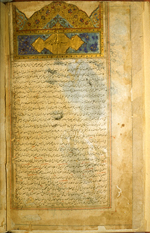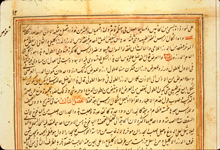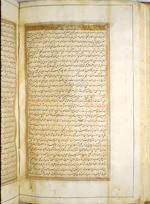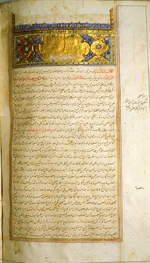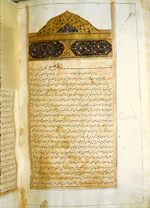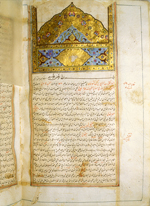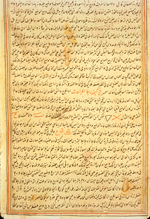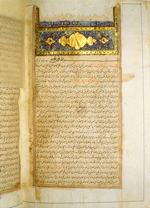Catalogue: Medical Encyclopedias
Encyclopedias
-
 Kitāb al-Qānūn fī al-ṭibb (MS A 53)
Kitāb al-Qānūn fī al-ṭibb (MS A 53) - (The Canon on Medicine)
- كتاب القانون فى الطب
- by Abū ‘Alī al-Ḥusayn ibn ‘Abd Allāh Ibn Sīnā
- known to Europeans as Avicenna (d. 1037/428 H)
- ابو على الحسين ابن عبد الله ابن سينا
This massive general medical encyclopaedia was composed over a lengthy period of time as its author moved westward from Gurgan in northern Iran, where it was begun, to Rayy near modern Teheran and then to Hamadan even further southwest, where it was completed. The sheer size of the encyclopaedia tended to reinforce its authoritative nature, and even its title Qānūn, meaning "canon" or "codes of law", contributed to this view. The Canon of Medicine was widely read by Europeans in the Latin translation of Gerard of Cremona made in the 12th century. So great was the interest in this mammoth medical textbook that late in the 15th century Girolamo Ramusio attempted to improve upon Gerard of Cremona's Latin translation by comparing it with an Arabic manuscript, and in 1527 a new Latin version was published that had been made by Andrea Alpago (d. 1522), who had resided in Damascus for thirty years as a physician in the service of the Venetian Republic and had used his fluency in Arabic not only to translate it but also to append an Arabic-Latin glossary of terms. Between 1500 and 1674 some sixty editions of part or all of the Canon were published in Europe, mostly intended for use in university medical training.
The work consists of five "books". The first book (Kitāb), also called al-kulliyat , concerns general medical principles and often circulated separately from the rest of the encyclopedia, especially in Europe. The second book is on simple drugs and materia medica, in alphabetical order. The third is on therapy, arranged in order of the site of the ailment from head to toe, in 22 chapters (funun). The fourth book is on those diseases not restricted to a single part of the body, such as fevers. The final book presents recipes for compound remedies.
Because of its enormous size, relatively few complete copies are preserved in either the original Arabic or in Latin. The National Library of Medicine has one of the few complete copies (MS A 53) -- a carefully executed copy probably made at the beginning of the 15th century in a Timurid workshop in Iran. Fine illuminated openings begin each of the five books. Two of the illuminated headings were done by the same person, who was possibly the master illuminator in the workshop, while those opening the other three books were probably executed by other, slightly less skilled, members of the same workshop of calligraphers and illuminators. An extra illuminated heading has been inserted in the middle of the third chapter; it was added later, probably in the 17th century.
Within the text itself there are small diagrams of the cranial sutures. Similar diagrams are found in earlier Arabic discussions of anatomy, though the origin of the diagram is unknown.
Only four other complete Arabic copies are recorded, all of them of a more recent date than the NLM copy: Florence (Laurent) no. 211; London, Wellcome Library for the History and Understanding of Medicine, MS Arab. 155, copied in 1632 (1042 H); and two in the British Library.
For other copies of the Canon on Medicine, see GAL, vol. 1, p. 457 (597) no. 82; GAL-S, vol. 1, p. 823-4 no. 82; Ullmann, Medizin, p. 152-3. Savage-Smith "Bodleian", MSS Pococke 47, Hunt. 196, Thurston 2, Bodl. Or. 263, Pococke 131, Marsh 138, Marsh 647, Bodl. Or. 702, Hunt. 23, and Ind. Inst. Arab. 3; and Gregor Schoeler, Arabische Handschriften, Teil II (Verzeichnis der orientalischen Handschriften in Deutschland, XVII,B,2) Stuttgart: Franz Steiner, 1990), p. 234.
In the Canon of Medicine by Avicenna, the discussions of anatomy are scattered throughout the huge encyclopaedia, with the anatomy of a particular organ being discussed in the section concerned with diseases particular to that organ. These anatomical sections of the Canon were often copied out and compiled as a separate treatise. Two manuscripts in the NLM collection illustrate this interest in the anatomical portions of the Canon. In one of the NLM copies, the margins contain extensive extracts from a commentary written by Ibn al-Nafīs (d. 1288/678H) on the anatomical portions of the Canon. In this commentary Ibn al-Nafīs criticized Avicenna for spreading his discussion of anatomy over many different sections of the Canon. And it was in this commentary that Ibn al-Nafīs explicitly stated that the blood in the right ventricle of the heart must reach the left ventricle by way of the lungs and not through a passage connecting the ventricles, as Galen had maintained. This formulation of the pulmonary circulation, sometimes called the 'lesser' circulation, was made three centuries before those of Michael Servetus (d. 1553) and Realdo Colombo (d. 1559), the first Europeans to describe the pulmonary circulation.
The anatomical portions (taken from the Bulaq/Cairo printing of 1877/1294 H) were printed and translated into French by Pieter de Koning, Trois traités d'anatomie arabes par Muhammad ibn Zakariyya al-Razi, ‘Ali ibn al-‘Abbas and ‘Ali ibn Sīnā (Leiden: Brill, 1903; reprinted Frankfurt: Institut für Geschichte der Arabisch-Islamischen Wissenschaften, 1986), p. 431-776.
There is no modern European-language translation of the entire Canon. A translation of the first book only, made from the medieval Latin version and not directly from the Arabic, was published by Cameron Gruner, A Treatise on the Canon of Medicine of Avicenna Incorporating a Translation of the First Book (London, 1930), and a translation of the first book only, made from an Urdu translation and also not directly from the Arabic, was published by Mazhar H. Shah, The General Principles of Avicenna's Canon of Medicine (Karachi: Naveed Clinic, 1966).
Kitāb al-Qānūn fī al-ṭibb (MS A 53)
Illustrations
Illuminated opening of the first book of the Kitāb al-Qānūn fī al-ṭibb (The Canon on Medicine) by ibn Sīnā (Avicenna). Undated; probably Iran, beginning of 15th century.
Small diagram(s) in red ink of cranial sutures.
Illuminated opening of the second book of the Kitāb al-Qānūn fī al-ṭibb (The Canon on Medicine) by ibn Sīnā (Avicenna). Undated; probably Iran, beginning of 15th century. The master illuminator producing this opening also did that on fol. 86b; both are products typical of Timurid workshops of the 15th century.
Illuminated opening of the third book of the Kitāb al-Qānūn fī al-ṭibb (The Canon on Medicine) by ibn Sīnā (Avicenna). Undated; probably Iran, beginning of 15th century.
Illuminated opening in the middle of the third book of the Kitāb al-Qānūn fī al-ṭibb (The Canon on Medicine) by ibn Sīnā (Avicenna). This heading has been added later, probably in the 17th century.
Illuminated opening of the fourth book of the Kitāb al-Qānūn fī al-ṭibb (The Canon on Medicine) by ibn Sīnā (Avicenna). Undated; probably Iran, beginning of 15th century. The master illuminator producing this opening also did that on fol. 86b; both are typical of products from Timurid workshops of the 15th century.
A talismanic design for use in treating fevers.
Illuminated opening of the fifth book of the Kitāb al-Qānūn fī al-ṭibb (The Canon on Medicine) by ibn Sīnā (Avicenna). Undated; probably Iran, beginning of 15th century.
Physical Description
Arabic. 492 folios. Dimensions 25.8 x 15.4 cm; text area 19 x 10 cm; 31 lines per page. The title is given as Kitāb al-Qānūn fi ‘ilm al-tibb (The Canon on the Art of Medicine) at end of first book (fol. 85a) and on fol. 86a. The title is given in shortened form as Kitāb al-Qānūn at the beginning of the fourth and fifth books (fols. 368b and 455b) and at the end of the treatise (fol. 492b). The author is named at the beginning of book four (fol. 368b line 2. This is a complete copy of the treatise, with Book I on the general principles of medicine beginning on fol. 1b, Book II on materia medica beginning on 86b, Book III on the treatment of diseases discussed head to foot beginning on fol. 157b, Book IV on diseases not specific to any one part of body beginning on 368b, and Book V on compound remedies beginning on 455b.
The copy is unsigned and undated; the nature of the script, illumination, and paper suggest that it was produced in the early 15th century. The text is written in small to very small nasta‘liq,with headings in naskh. Black ink with headings in red. There are catchwords, rubrications, red overlinings; some later black overlinings with headings added casually in margins.
The text is written on a thin brown paper with no visible laid or chain lines; except for the first two folios, all the text has been cut out and set within borders of white watermarked paper. The paper forming the frame is probably 17th-century paper; that on which the text is written is probably 15th-century. A frame of blue, black and red ink and gilt has been drawn around the text area; a larger frame of a single blue ink line is also on the bordering frame of each folio. The catchwords and marginalia of the original text have also been cut out and pasted onto the more recent border. The paper has worm holes, some water damage and some repairs; folios have been numbered in Arabic numerals after having been set into frame of more recent paper; folios recently renumbered in Western numerals. Older marginalia giving emendations have been cut out and pasted onto the more recent borders; other recent marginalia occur occasionally; fols. 368b-378b contain many Persian marginal notations and interlinear notes.
Illuminated openings begin each book; an extra one in the middle of the third book (fol. 300b) has been added later, probably in the 17th-century; two of the illuminated headings (fol. 368b and fol. 86b) were done by the same master illustrator and are in keeping with a Timurid workshop of the fifteenth century; the others (fols. 1a, 157b, and 455b) were probably done by other members of the same workshop. There are small diagrams in red ink of the cranial sutures on fols. 11b and 12a, and a talismanic design for use in fevers is drawn on fol. 404b. Fols. 157a, 300a, 368a, and 455a are blank Fols. 85b and 156b are blank except for two Persian quatrains; fol. 1a is blank except for owners's notes. Fol. 43 (recent numbering) should be placed between fols. 49 and 50; fol. 477 (new numbering) should be placed after 491 (new numbering).
Binding
The volume is bound in a modern tan leather library binding over paper pasteboards; modern marbled pastedowns and endpapers.
Provenance
Two owners' notes, one dated Jumadá I 1225 (June 1810), are on fol. 1a and paper has been pasted over other notes on that folio. Fol. 85a has an owner's stamp dated 1286 H (= 1869-70) and a note dated 1290 H (1873-4), both badly effaced, and similar effaced notes are on fols. 156a, 299b, 367b, 454b, and 492b. Another undated owner's stamp is on fol. 233a, and two defaced stamps are on fols. 245a and 267a.
The volume was purchased in 1941 by the Army Medical Library from A.S. Yahuda who acquired it from a dealer in Lucknow (in modern India); it has an earlier catalogue label reading Med ELSinao. 1640.
References
Schullian/Sommer, Cat. of incun. & MSS, p. 315, entry A53; Hamarneh, "NLM", p. 90.
NLM Microfilm Reel: FILM 48-122 no. 5

